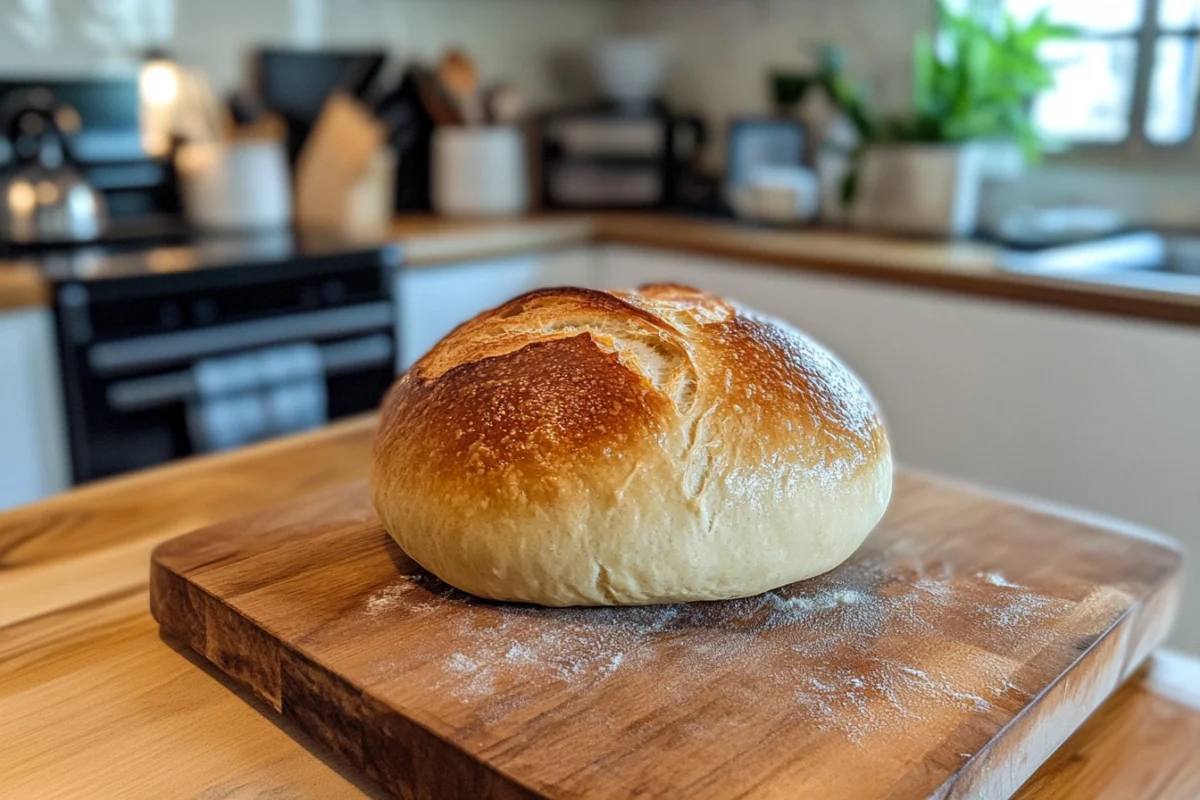Why are sourdough bagels chewy? This article explores the factors behind their natural chewiness and how to achieve the perfect texture.
The Natural Science Behind Chewy Sourdough Bagels
Sourdough bagels are loved for their unique texture. But why are some bagels chewier than others? The natural answer lies in a combination of factors. Therefore, understanding these elements is key to baking the perfect bagel.
If hydration puzzles you, read our guide on How to Keep Pound Cake Moist, which discusses the importance of balancing moisture in baked goods.
The Role of Flour in Natural Chewiness
Firstly, the type of flour used significantly impacts chewiness. Bread flour, for example, has a high protein content. Protein is essential for developing gluten, which creates the structure that gives bagels their chew.
Secondly, strong flours, such as those high in protein, form a more robust gluten network. Consequently, this leads to a chewier bagel. In contrast, using lower-protein flours results in a softer texture.
Furthermore, the specific type of wheat used to make the flour also matters. Hard wheat varieties, for example, are typically higher in protein than soft wheat varieties. Thus, choosing the right flour sets the stage for the desired chewy result.
Moreover, the freshness of the flour can also play a role. Older flour may have reduced gluten-forming capabilities. Therefore, always use fresh flour for the best outcome.
Hydration’s Natural Impact on Texture
Water is another critical ingredient. The amount of water, or hydration level, affects dough consistency. Higher hydration doughs tend to produce chewier bagels because more water allows for better gluten development.
Furthermore, the more developed the gluten, the chewier the bagel. However, too much water can make the dough hard to handle. Consequently, finding the right hydration level is important for achieving the desired texture.
In addition, the temperature of the water can also play a role. Using lukewarm water can promote faster gluten development.
Moreover, the way you add the water matters too. Adding it slowly and gradually helps ensure even distribution and absorption. Therefore, pay close attention to both the amount and the method of water addition.
Fermentation: The Natural Key to Flavor and Texture
Sourdough uses wild yeast and bacteria for fermentation. The fermentation process, naturally, is long and slow. This slow fermentation affects both the flavor and texture of the bagel. During fermentation, natural acids develop. These acids alter the gluten and add tanginess. The extended fermentation also allows the gluten to relax. This relaxation creates a softer, yet still chewy, bagel. Moreover, the longer fermentation also increases the digestibility of the bagel. Because of this, long fermentation is generally preferred. Additionally, different sourdough starters will have different levels of activity. Therefore, adjusting fermentation times according to starter activity is essential. Therefore, understanding the specific nature of your starter is very important.
The Natural Significance of Shaping Techniques
The shaping of the bagels also matters. A well-formed, tight bagel will have a more uniform texture. Conversely, poorly shaped bagels might have inconsistent chew. Therefore, proper shaping techniques are very important. Indeed, learning to shape correctly enhances the final texture. For instance, you need to make the dough firm before boiling it. Moreover, a tight shaping also helps create a more even crust. Furthermore, consistent shaping ensures uniform baking throughout the batch. Therefore, mastering the art of bagel shaping is worth your time. Be sure to use a gentle touch so you don’t deflate the dough.
Boiling, Baking, and the Natural Chew
The boiling process is unique to bagel-making. Boiling the bagels before baking sets their shape. It also starts the gelatinization of the starches. This gelatinization contributes to the bagel’s crust and chew. The baking process, therefore, further develops the texture and flavor. Proper oven temperature ensures a well-baked and chewy bagel. Moreover, the timing of the baking can also affect the overall texture.
The Importance of the Boiling Step for Natural Results
Boiling bagels creates a slight crust before baking. This step is naturally essential for a proper bagel. The boiling process sets the exterior of the bagel. This step, consequently, gives the bagel its distinct chew. Furthermore, it helps prevent the bagel from spreading too much during baking. Therefore, never skip this crucial boiling process. Moreover, the water should be at a rolling boil for optimal results. Additionally, you can add malt syrup or baking soda to the boiling water to enhance the crust. The addition of these ingredients can help create a slightly sweeter and chewier bagel. Thus, this step is both science and a bit of magic.
Baking Time and Temperature for Naturally Chewy Texture
Baking time and temperature are equally important. Baking too short will result in undercooked bagels. Baking at the wrong temperature will affect the texture, too. Therefore, find the right temperature for your oven. In addition, be sure to bake the bagels for the correct amount of time. A properly baked bagel is evenly browned and chewy. Furthermore, using a baking stone or sheet can ensure even heat distribution. Also, you might consider using an oven thermometer to ensure accurate temperatures. Moreover, rotating the baking tray halfway through baking ensures even browning. Therefore, keep a close eye on your oven settings for best results.
Understanding Cooling for Naturally Enhanced Results
The cooling process is often overlooked. However, it is an important step for natural results. Allow your bagels to cool fully after baking. This allows the starches to set properly, enhancing the chew. Cutting into a warm bagel can result in a gummy texture. Therefore, patience is key for achieving the perfect chew. In addition, placing the bagels on a wire rack can promote even cooling. Also, this allows air circulation around all sides of the bagel. Moreover, avoiding placing them in a closed container while warm can prevent them from becoming soggy. Therefore, letting them cool properly is essential.
Common Mistakes Affecting the Natural Chewiness
Several common mistakes can lead to less-than-perfect chew. Therefore, knowing these can help you avoid them. Always be precise with your recipe. A naturally balanced recipe will get you better results. In addition, always be aware of how your dough looks and feels.
Over-mixing the Dough and its Impact
Over-mixing the dough can be an issue. Over-mixing develops too much gluten. This can lead to a tough, rather than chewy, bagel. Conversely, under-mixing can result in a crumbly texture. Therefore, find the right balance when kneading your dough. Aim for a smooth and slightly tacky dough texture. Furthermore, using a stand mixer on low speed can help prevent over-mixing. Also, being aware of the signs of well-developed gluten is crucial. Moreover, the dough should feel smooth and elastic, not stiff. Thus, stop kneading as soon as the dough reaches that texture.
Using Inactive or Weak Sourdough Starter
The strength of your sourdough starter matters. A weak starter will not produce enough gas for a proper rise. Therefore, your starter must be active and bubbly. A healthy starter is naturally essential for achieving the desired chew. Furthermore, feed your starter regularly. A well-fed starter will give you excellent results. In addition, observe your starter closely for signs of activity. Moreover, a starter that doubles in size within hours is ready for use. Also, keeping your starter at a consistent temperature is important for maintaining its health. Therefore, a little extra care for your starter can go a long way.
Not Allowing Enough Fermentation Time for Natural Flavor
Sourdough fermentation takes time. Rushing this process affects both flavor and texture. Consequently, patience is crucial. The longer the fermentation, the more developed the flavor and texture will be. Therefore, give your dough enough time for a good ferment. A good, long, fermentation process adds to the natural flavor. Also, bulk fermentation is a key step for flavor development. Moreover, cold fermentation in the fridge can slow down the process while adding complexity. Thus, experiment with various fermentation times to find your preferred taste and texture.
Skipping or Incorrectly Executing the Boiling Step
Skipping the boiling step will result in a completely different bagel. The boiling process is naturally essential for that classic bagel texture. Therefore, always boil the bagels briefly before baking. The boiling step is what gives bagels their unique, chewy texture. Furthermore, be sure to boil the bagels for the correct amount of time on each side. Also, adding a bit of malt or honey to the boiling water can enhance color and flavor. Moreover, using a slotted spoon can help carefully remove bagels from the boiling water. Therefore, execute this step with precision for great results.
Tips for Achieving Naturally Chewy Sourdough Bagels
Getting chewy bagels involves practice. However, following some key tips can improve your results. You must always be precise and patient. Therefore, following these simple tips is important for success.
Precise Measurements for Naturally Consistent Results
Accurate measurements are key in baking. Baking is a science. Therefore, precise measurements are important. Use a kitchen scale for the best accuracy. In addition, this will give you more consistent results every time you bake. Consistency is very important when trying to get the best results. Moreover, measuring ingredients by weight is more accurate than by volume. Also, be sure to tare your scale before each measurement. Therefore, use the scale to precisely add each ingredient.
Developing the Dough Thoroughly for Naturally Strong Gluten
Knead the dough well to develop a strong gluten network. Strong gluten equals a chewier texture. Consequently, take your time when kneading. Proper gluten development is a must. A well-kneaded dough will produce a superior bagel. Furthermore, use the windowpane test to check for adequate gluten development. Also, a smooth, elastic dough is the goal of proper kneading. Therefore, be sure to knead until the dough passes the windowpane test.
Allowing Enough Time for Fermentation for Natural Flavors
Give the dough adequate time to ferment. Long fermentation contributes to both flavor and texture. For instance, overnight fermentation is ideal for sourdough. A slow ferment develops complex flavor profiles. In addition, a long ferment makes the gluten more relaxed. Moreover, monitor your dough’s volume to gauge fermentation. Also, you can adjust fermentation times based on your ambient temperature. Therefore, understand and adapt to your fermentation environment.
Boiling the Bagels Correctly for Naturally Great Results
Boil the bagels briefly in a pot of water before baking. Make sure that you boil them for no more than 60 seconds. The boiling process sets the bagel’s exterior. Boiling is, naturally, key for the characteristic texture. Furthermore, don’t overcrowd the pot while boiling. Also, a large pot will help maintain consistent water temperature. Therefore, use a big pot to help with this key step.
Adjusting Based on Your Environment for Naturally Good Baking
Baking environments can vary greatly. Adjust your techniques based on your specific conditions. In other words, room temperature and humidity affect dough. Therefore, adjust fermentation times as needed. Naturally, warm weather requires less fermentation time. Practice and observation are essential for perfection. Moreover, keep detailed notes of your baking sessions. Also, adjust accordingly for future baking. Therefore, learning how to adapt to your environment will help you improve.
Understanding Natural Variations in Sourdough
Sourdough is a natural product. Therefore, it is subject to some variations. These variations can occur due to the flour or the environment. Understanding these variations is key for any sourdough baker. Indeed, natural variations are common in sourdough baking. Furthermore, embrace these variations. Also, they are part of the charm of sourdough.
The Influence of Flour Brands on Natural Outcomes
Different flour brands have different protein levels. This affects the gluten development. Consequently, experiment with various brands. Find the one that gives you the best result for your bagels. Therefore, knowing your flour is crucial. Moreover, look for flour specifically labeled for bread baking. Also, different milling processes can result in varying flour characteristics. Therefore, try out a range of flour to see which you like.
How Temperature Affects Fermentation Rates
Room temperature greatly influences fermentation. Warm temperatures speed up fermentation. Conversely, cold temperatures slow it down. Therefore, adjust your fermentation times accordingly. Naturally, warm weather requires less fermentation time. Furthermore, consider using a fermentation chamber if your house is too cold. Also, cold proofing in the fridge can help manage your fermentation. Therefore, understanding how temperature affects yeast activity is important.
Humidity’s Impact on Dough Consistency
Humidity also affects dough. High humidity can make the dough sticky. Consequently, you might need to adjust the hydration level. Therefore, learn to recognize the impact of your environment. A little experience will make a huge difference. Moreover, using a dehumidifier or humidifier can help regulate your environment. Also, adding a bit of extra flour can help manage a sticky dough. Therefore, adapt based on your kitchen conditions.
The Naturally Evolving Nature of Sourdough Starter
Sourdough starters are living cultures. Therefore, their activity levels can change over time. Be sure to understand these changes and adjust accordingly. A starter’s health is key to successful sourdough. Furthermore, it must be properly maintained. Also, the feeding schedule of the starter has a huge impact. Moreover, the consistency of the starter can also affect results. Therefore, pay close attention to the health of your sourdough starter.
Frequently Asked Questions About Sourdough Bagel Chewiness
Why are my sourdough bagels so tough instead of chewy?
Tough bagels often result from over-kneading or too little fermentation. Additionally, using the wrong flour or baking at the incorrect temperature can also affect the texture. Therefore, you need to pay careful attention to the dough handling. Also, adjust your baking temperatures as needed. Finally, pay attention to your fermentation times to get the right chewiness. Furthermore, consider adjusting your recipe with each baking attempt. Moreover, small changes in your baking process can make a huge impact on the end results.
Does adding malt powder make bagels chewier?
Malt powder can enhance the bagel’s chew. It adds sugars that feed the yeast. It also helps with the browning process. Additionally, it can help with the crust texture. Use malt powder in small amounts, and the effect will be noticeable. This small addition can greatly help with the texture. Furthermore, the type of malt powder, either diastatic or non-diastatic, also impacts the bagels differently. Also, diastatic malt powder assists with fermentation. Therefore, consider your goals when choosing your malt powder.
Why is my bagel dough so sticky?
Sticky dough can result from using too much water. It can also happen with high humidity. Moreover, under-kneading can also result in a sticky dough. Adjust your water content to get the correct consistency. When kneading, add flour as needed to achieve a smooth and elastic dough. Furthermore, adding flour in small increments is better than adding too much. Also, a slightly sticky dough is easier to work with. Therefore, adjust hydration with careful additions.
How can I tell if my sourdough starter is active enough for bagels?
An active starter should be bubbly and have a pleasant, tangy smell. If the starter doubles in size within a few hours of feeding, it’s ready to use. The better your starter is the better your bagels will taste. An active starter is naturally important. Use a healthy and bubbly sourdough starter. Furthermore, using a float test can also help you know when the starter is ready. Also, regular feeding is important for maintaining starter health. Therefore, pay attention to your starter.
Conclusion: Mastering the Natural Art of Sourdough Bagel Chewiness
In conclusion, achieving that naturally perfect chewy sourdough bagel requires a keen understanding of the baking process. Flour type, hydration, fermentation, and baking techniques are all important. By paying attention to these elements, you can bake exceptional sourdough bagels. Remember that natural sourdough baking is both a science and an art. The more you practice, the better your bagels will become. Moreover, don’t be afraid to experiment with different flours and fermentation times. Also, keep a detailed log of your baking to help identify the perfect formula. Therefore, be patient and keep practicing. Also, remember that baking is all about the journey. Embrace the process and keep working to achieve the perfect chewy bagel!
For more on the role of gluten, check out Secrets of Puff Pastry, where gluten’s role in baking is explored in detail.



